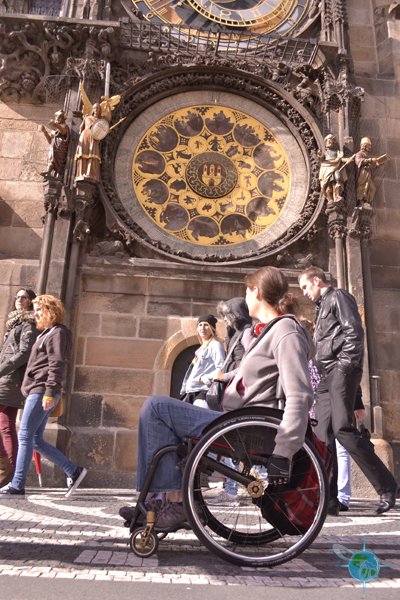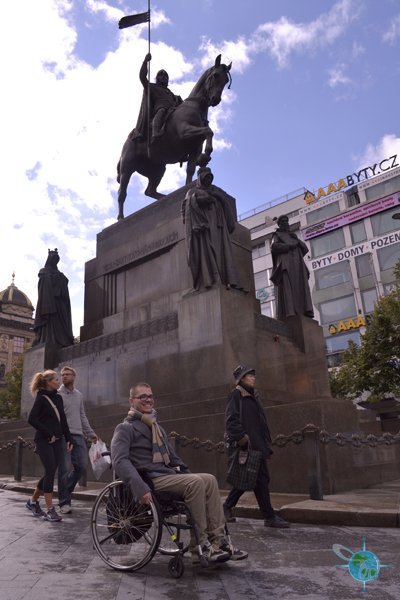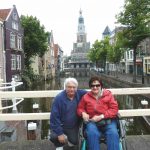As our office is located in Prague, the capital and one of the world’s most magnificent historic cities, we are experts at providing especially wheelchair users with guide services in its historic center listed by UNESCO since 1992. The historic city of Prague, rich in monuments from all periods of its history, comprises three separate cities – the charming Old Town (Staré Město) on the left bank of the river with the Gothic sights, then the picturesque Lesser Town (Malá Strana) with Prague Castle complex, and the late 19th century buildings of the New Town (Nové Město).
Book your accessible tour to Prague today, contact Bezbtour.
Prague Attractions
Probably the most visited and important sights of the medieval Old Town are the Gothic arcaded houses around the Old Town Square (Staroměstské náměstí). This most significant Prague square is visited basically because of the most well-preserved medieval Astronomical Clock (Orloj) to watch the apostles move. The 69,5 m tall Town Hall Tower, hosting the astronomical clock, was built in the 14th century. It is now open for tourists including wheelchair users and offers one of the most comprehensive views of Prague. Unique will be not only the view over the narrow Celetná Street but also the look at Prague’s main places of interest. The gate to Celetná Street from its opposite side is the 65m-tall Powder Tower from 1475. It used to form one of the 13 entrances to the Old Town and was built in concordance with the Old Town Bridge Tower. The gate acquired its present name in the 17th century when it was used to store gunpowder. The tower, open for visiting, is not accessible but it is not true about the nearby Municipal house, the most spectacular Art Nouveau building in Prague. Its interior is decorated with the works of the best Czech artists from the first decade of the 20th century. Its Smetana Hall is the principal concert hall in Prague.
A link between the Old Town and the Lesser Town is Charles Bridge built in 1357. The nearly 520 meters long construction initiated by King Charles IV is formed by 16 monumental arches and both sides are lined by 30 Baroque statues and groups of statues. There are towers on both ends, the Lesser Town Bridge Tower and the Old Town Bridge Tower. As the bridge has been identified only for pedestrians since 1965, you can take your time and have beautiful views along the river before reaching Lesser Town. If you continue across it uphill, you can get to the most extensive sight of the capital, Prague Castle. It was founded by Premyslid Prince Bořivoj in 880 and the crown jewels are kept there now. The fully accessible Prague Castle Picture Gallery houses a part of Emperor Rudolf II’s original art collection which was one of the largest in the world at the time. The Gothic Cathedral of St Vitus, most of which is accessible thanks to steeper metal ramps, dominates the whole courtyard and is the most distinct medieval building in Prague. It is 124m long, 33m high, and 60m wide at its widest point. 28 pillars support the amazing vaulted ceiling. At the top of the 96.5m-high tower stands a 3.5m high Czech lion. The largest bell in the Czech lands dating from 1549 and weighing 16.5 tons hangs in the tower.
The Old Royal Palace is situated to the south of the cathedral and is one of Prague Castle’s oldest structures. Its accessible parts are the vestibule, Czech Office, Vladislav Hall, and the Old Parliament. It is possible to have a look at the Horse-riding Stairs. The Theresian Wing of the Old Royal Palace is accessible only through the South Gardens. The wheelchair partly accessible Basilica of St George is the best preserved Romanesque place of worship in Prague. The only ‘blemish’ on the purely Romanesque character is the baroque façade from the 17th century. The twin spires of the basilica (named Adam and Eva) are a well-known sight. The tomb of St Ludmila, the Přemyslid dynasty princess and patron saint of the Czech lands who was murdered in the 9th century, is also situated in the basilica, however, the crypt and presbytery are inaccessible. But the concert hall of the Lobkovicz Palace, next to the easternmost gate into Prague Castle, offers a special cultural experience: a classical music concert that takes place here every day. It is accessible through the service lift so it is necessary to ask the security guards for assistance.
The Golden Lane (Zlatá ulička), named after the goldsmiths who lived here in the 17th century, is located on the eastern flank of Prague Castle, right up against the ramparts. Even if wheelchair users will not get into the particular houses, the houses are worth seeing from the outside. The Lane, one of Prague’s most picturesque places, is shrouded in myths and legends about alchemists trying to make a stone of wisdom, which would transform ordinary metals into gold. The Golden Lane was home to the castle guardsmen and later it attracted the poor so the name ‘Golden’ was used in irony as the place was so dirty. The inhabitants, it is said, had only one toilet and an open sewer ran down the middle of the lane. It wasn’t until the turn of the 19th when the lane was renovated, and several famous writers lived here including Franz Kafka in 1917, who lived at No. 22, and the poet Jaroslav Seifert, winner of the Nobel Prize for Literature.
However, many other famous and interesting personalities lived in Prague – except Franz Kafka also the painter Alfons Mucha. Museums of both are fully wheelchair accessible and worth visiting. But Prague offers plenty of museums and galleries to check out. The largest one in the country, the National Museum founded in 1818, is an imposing Neo-Renaissance building dominating the upper part of Wenceslas Square. Even if the building is fully accessible, it is closed since 7 July 2011 for 7 years due to the first general reconstruction after 120 years. The opening is planned for the 200th anniversary of the National Museum in 2018. Wenceslas Square is ranked among the most popular cultural and shopping centers of Praguers. A frequent sentence that you can hear from the locals is: „Where shall we meet? How about Wenceslas Square under the horse’s tail?“ It is because, at the top of the square, there is a statue of King Wenceslas on a horse accompanied by other Czech patrons such as St. Ludmila (svatá Ludmila), St. Agnes (svatá Anežka), St. Prokop (svatý Prokop) and St. Adalbert (svatý Vojtěch). The group of statues has become the Czech national symbol.
Even if cobblestones and the old architecture may be intimidating for wheelchair travelers, exploration is possible and always easier if you hire someone familiar with the area. So while in Prague, you may want to look into doing a tour with us. Our offer also includes accessible sports activities or cruises on the Vltava River. In case you prefer to go sightseeing by yourselves, we are prepared to provide you with all the necessary information on how to get to accessible sights or we can ensure accessible transportation and, of course, accommodation for you no matter if you prefer to stay in the heart of Prague or its suburbs. For example, you can stay at Aquapalace Hotel there, the hotel of Central Europe’s largest covered Aquapark, where except Water World you can also enjoy Sauna World with a chance to try any of the unique sauna ceremonials in classical Finnish saunas or Roman spas in Turkish style. The whole resort including a 4-star hotel is located near the Průhonice Chateau and Park, which is also part of UNESCO heritage.
If you are looking for an oasis of peace and tranquility in Prague, there are many other gardens and parks to visit. The Botanical garden has excellent wheelchair access not only to the area of open-air expositions with various gardens including the Japanese Garden but also to the Fata Morgana tropical greenhouse with a unique botanic exposition divided into three thematic blocks. If you are already there, you should not omit the nearby Troja Castle, very sensitively inserted in the extensive French garden, or Prague Zoological Garden where you can also borrow a stroller, a cart, or a wheelchair free of charge from the main entrance to the zoo.
However, the Czech Republic is not only Prague. Thanks to Bezbatour TA you can try the effects of the well-known Czech spa on your own body in such a famous place as Carlsbad (Karlovy Vary). In addition to beautiful walks along the colonnades, an opportunity for a magnificent view of the whole city nestled in a picturesque valley arises for you. It is right here where the International Film Festival is held annually, an integral part of which is the project of Cinema without Barriers named “No Barriers.” Its aim is a service for wheelchair users and their assistants such as to get information about wheelchair accessible accommodation and restaurants and to book free cinema tickets or free accessible transport in the city center or 7 km away from it.
The Czech Republic, rich in history, has many castles and chateaux but few of them are so accessible as medieval Castle Zbiroh (near Pilsen) from the end of the 12th century. The place is associated with many superlatives: the original castle area is dominated by the oldest watchtower in the country, it’s a shelter of the deepest well in Europe and it is ornamented by one of the oldest Bohemian castle chapels. Castle itself and its picturesque surroundings became a popular location for many significant personalities such as the painter Alfons Mucha, who was residing at the castle for almost 20 years and finished here his famous cycle of 20 large-scale canvases of Slavic Epic. The castle exposition with the attractive story of knight Templars is open daily all year round.
The Czech Republic is also a country of amazing gourmet experiences. We will be pleased to provide you with an accessible brewery tour and tasting of the famous Czech beer no matter if it is in the world-known Pilsen or Lety, a small village near Prague, with a unique possibility of accommodation in a stylish hotel owned by the brewery itself. Its surroundings call for trips and a visit to courtyards of the most famous medieval Czech castle named Karlštejn, which was founded by King Charles IV in 1348. You can also visit the French and English gardens of the near rococo Dobříš Palace considered the most luxurious palace in the Czech Republic. Especially, the floral ornaments and trimmed hedges of the French garden, which is a pearl among gardens in the country and a rare example of rococo garden architecture, evoke the atmosphere of Schönbrunn in Vienna. The gardens (as well as the inaccessible palace) are open all year round.
Our agency is prepared to fulfill your desires also in case you are a nature enthusiast. There is the Šumava National Park with a high density of cycle paths suitable also for wheelchair users and a popular recreation area near Lipno Dam. It is a part of the Vltava River cascade situated in mountainous terrain on the border of the Šumava National Park and Nature Reserve in the south of the Czech Republic. We can arrange wellness and even sports activities for physically challenged guests there, as well as in the near City of Frymburk. If you wish to visit the German part of Šumava named the Bavarian Forest National Park, be sure not to miss the world´s longest tree top walk in 8 to 25m height in unspoiled nature. The path, 1300 meters long, winds up to an impressive tower with a height of 44 meters. It gives access to all kinds of visitors including wheelchair users. You will discover an extraordinary and almost “borderless” view: towards Neuschönau it will be the vast unpopulated area of wild landscape and, on a clear and sunny day, even the silhouette of the Alps.
In the area called Czech-Saxon Switzerland in the north of the Czech Republic, there is the Bohemian Switzerland National Park, the fourth and the youngest Czech national park. It links to the Saxonian Switzerland National Park on the German side, which was established 10 years prior (1990). The bilateral whole of the Bohemian and Saxonian National Parks provides a representative example of the thick-bedded sandstone of the Bohemian Chalk Basin, which, with its vastness (a total of 172 km²) and its current low level of settlement (there are only two small villages within the territory of both national parks), has no equivalent in Europe.
It is countryside full of wonderful rocky formations, towers, gates, ravines, passes, picturesque canyons, and lookout points where we can also recommend numerous routes for wheelchair users. You can fully enjoy a walk along the Elbe (Labe) river or you can visit the lookout point from which you can see the overwhelming beauty of the whole valley. You can also get to the so-called Rose Lookout, the reward for which is the breathtaking and unique lookout to the City of Děčín, Děčínský Sněžník table mountain, and the Elbe Valley. Fully accessible Děčín Castle, one of the oldest and largest landmarks in northern Bohemia, is perched atop its cliff where the Ploučnice meets the Elbe. It is the place where Fryderyk Chopin composed his world-known waltz As-dur called the Děčín Waltz (Děčínský). You can feel the atmosphere and linger in the chambers of its former lords, enjoy wonderful views of the town, or succumb to the uncommon magic of the Rose Garden (the most attractive part of the castle which is, however, one step).
Besides Prague, the capital, and Bohemia, there is also Moravia, the eastern part of the Czech Republic, known for its grape-growing and wine-producing tradition. It offers the possibility of the finest wine-tasting experience in our country. Just visit the historical wine village Lednice, which is thanks to its beautiful surroundings known as the Garden of Europe. Lednice, one of the Czech sights on the UNESCO list, imitating the style of the English Tudor Gothic, also attracts visitors. Summer residence of the princely family of Lichtenstein is partially wheelchair accessible: accessibility is granted in the first route of the guided tour (a ramp through the three shallow steps leading to the cash desk) and in the greenhouse (possibility to use the side entrance). Even in the area of Lednice, we are able to secure accommodation for you to have a chance to stay there as long as you wish.
Whichever part of the Czech Republic you will choose for your holiday, you will not be disappointed. Travel agency Bezbatour will do everything for your pleasure, convenience, satisfaction, and great memories.
Additional Information
- Fees: Price is based on group size and the itinerary of the tour.
- Transportation: Bezbatour cooperates with transportation companies with a variety of vehicles. One company offers transportation by 16 specially-adapted microbusses (Mercedes-Benz and Ford Transit) with a capacity of 7 – 11 seats which can be arranged according to the number of wheelchair users. Wheelchair friendly taxi service is also available for individual travelers. Clients can order transfers from/to the Airport.
- Restrooms: Wheelchair accessible restrooms are not a problem in Prague. They can be found in shopping malls, McDonald’s, KFC, and other restaurants, and public buildings such as libraries, city hall, museums, and public toilets. Accessible restrooms are not everywhere in Prague however we have detailed information about them. When clients wish to travel to regions outside Prague, we are able to gather information about accessible restrooms in places they visit.




























I use wheelchair to get around .Interested in a tour to Prague. Please provide more info. thanks
Hi Rod! Please email the company directly @ prodej@Bezbatour.cz. They can answer all the details.
I am traveling to Prague soon with a friend. I will need to be able to take my own wheelchair. What excursions can you offer and how much. I am staying at the Best Western Plaaza Hotel.